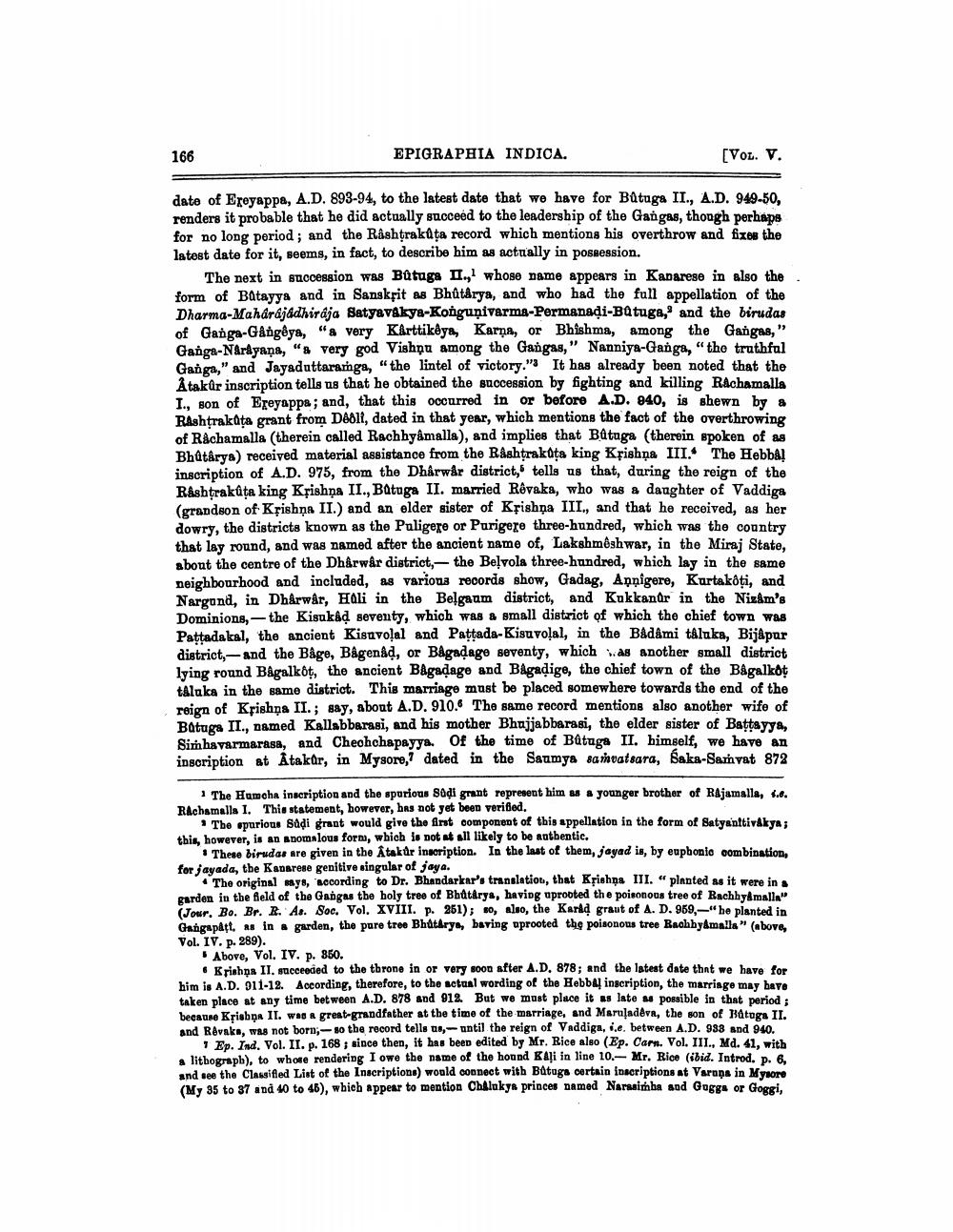________________
166
EPIGRAPHIA INDICA.
[VOL. V.
date of Exeyappa, A.D. 893-94, to the latest date that we have for Bûtuga II., A.D. 949-50, renders it probable that he did actually succeed to the leadership of the Gangas, though perhaps for no long period; and the Rashtrakuta record which mentions his overthrow and fixes the latest date for it, seems, in fact, to describe him as actually in possession.
-
The next in succession was Bûtuga II., whose name appears in Kanarese in also the form of Batayya and in Sanskrit as Bhûtârya, and who had the full appellation of the Dharma-Maharajadhiraja Satyavakya-Kongunivarma-Permanaḍi-Batuga," and the birudas of Ganga-Gangêya, "a very Karttikêya, Karna, or Bhishma, among the Gangas," Ganga-Narayana, "a very god Vishnu among the Gangas," Nanniya-Ganga, "the truthful Ganga," and Jayaduttaramga, "the lintel of victory." It has already been noted that the Atakûr inscription tells us that he obtained the succession by fighting and killing Rachamalla I., son of Ereyappa; and, that this occurred in or before A.D. 940, is shewn by a Rashtrakuta grant from Déôlt, dated in that year, which mentions the fact of the overthrowing of Råchamalla (therein called Rachhyâmalla), and implies that Bâtuga (therein spoken of as Bhútarya) received material assistance from the Rashtrakuta king Krishna III. The Hebbal inscription of A.D. 975, from the Dhârwâr district, tells us that, during the reign of the Rashtrakuta king Krishna II., Batuga II. married Rêvaka, who was a daughter of Vaddiga (grandson of Krishna II.) and an elder sister of Krishna III., and that he received, as her dowry, the districts known as the Puligere or Purigere three-hundred, which was the country that lay round, and was named after the ancient name of, Lakshmêshwar, in the Miraj State, about the centre of the Dharwâr district, the Belvola three-hundred, which lay in the same neighbourhood and included, as various records show, Gadag, Annigere, Kurtakôți, and Nargund, in Dharwar, Hali in the Belgaum district, and Kukkanûr in the Nizam's Dominions, the Kisukâd seventy, which was a small district of which the chief town was Paṭṭadakal, the ancient Kisuvolal and Paṭṭada-Kisuvolal, in the Bâdâmi taluka, Bijapur district, and the Bâge, Bâgenâd, or Bågaḍage seventy, which as another small district lying round Bagalkot, the ancient Bagaḍage and Bagadige, the chief town of the Bagalkot tâluka in the same district. This marriage must be placed somewhere towards the end of the reign of Krishna II.; say, about A.D. 910. The same record mentions also another wife of Batuga II., named Kallabbarasi, and his mother Bhujjabbarasi, the elder sister of Baṭṭayya, Simhavarmarasa, and Chechchapayya. Of the time of Batuga II. himself, we have an inscription at Atakar, in Mysore,7 dated in the Saumya samvatsara, Saka-Samvat 872
1 The Humcha inscription and the spurious Südi grant represent him as a younger brother of Rajamalla, 1.6. Rachamalla I. This statement, however, has not yet been verified.
The spurious Sâdi grant would give the first component of this appellation in the form of Satyanitivåkya; this, however, is an anomalous form, which is not at all likely to be authentic.
These birudas are given in the Âtakûr inscription. In the last of them, jayad is, by euphonic combination, for jayada, the Kanarese genitive singular of jaya.
The original says, according to Dr. Bhandarkar's translation, that Krishna III. " planted as it were in a garden in the field of the Gangas the holy tree of Bhûtarys, having uprooted the poisonous tree of Rachhy&malla" (Jour. Bo. Br. R. As. Soc. Vol. XVIII. p. 251); so, also, the Karad graut of A. D. 959,-"he planted in Gangapati, as in a garden, the pure tree Bhútarys, baving uprooted the poisonous tree Rachhyamalla" (above, Vol. IV. p. 289).
Above, Vol. IV. p. 850.
Krishna II. succeeded to the throne in or very soon after A.D. 878; and the latest date that we have for him is A.D. 911-12. According, therefore, to the actual wording of the Hebbal inscription, the marriage may have taken place at any time between A.D. 878 and 912. But we must place it as late as possible in that period; because Krishna II. was a great-grandfather at the time of the marriage, and Maruladeva, the son of Batuga II. and Rêvaka, was not born;-so the record tells us, until the reign of Vaddiga, i.e. between A.D. 938 and 940.
1 Ep. Ind. Vol. II. p. 168; since then, it has been edited by Mr. Rice also (Ep. Carn. Vol. III., Md. 41, with a lithograph), to whose rendering I owe the name of the hound Kali in line 10.- Mr. Rice (ibid. Introd. p. 6, and see the Classified List of the Inscriptions) would connect with Batuga certain inscriptions at Varans in Mysore (My 35 to 37 and 40 to 45), which appear to mention Chalukya princes named Narasimha and Gugga or Goggi,




